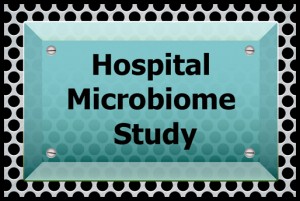The Sloan Foundation has just announced funding for another two projects, we’ll be posting details here.
The first project is called the “Hospital Microbiome Study” and will be managed by Jack Gilbert (University of Chicago) and Captain Benjamin Kirkup at the Walter Reed Army Institute of Research. Check out the project website here.
The Hospital Microbiome Project
The Hospital Microbiome Project represents a consortium of researchers interested in exploring the development and distribution potential of microbial communities in the hospital environment. The consortium is led by Jack Gilbert at the University of Chicago (http://pondside.uchicago.edu/ecol-evol/people/gilbert.html) and Captain Benjamin Kirkup at the Walter Reed Army Institute of Research (http://wrair-www.army.mil), and focuses on the analysis of a new hospital building in Chicago, and an operating room of a medical treatment facility in Germany. The study was developed from a Sloan-funded workshop held at University of Chicago in June 2012. The workshop was designed to help focus the research potential for hospital studies of microbial ecology, bringing together medical doctors, infectious disease epidemiologists, building scientists, modelers, microbial ecologists, virologists, and statisticians. The findings from this workshop are the focus of a Workshop Report, in review at Standards in Genomic Science, and an Institute of Medicine report on sampling strategies for hospital microbiome studies.
The strategy and associated information regarding the consortium study is present on the www.hospitalmicrobiome.com website. Briefly, the proposed sampling design will test four hypotheses concerning the microbial interaction of multiple populations with the hospital infrastructure, and develop possible recommendations for best practice in reducing hospital acquired infections. In Chicago, 12,392 samples will be collected using sterile swabs from patients, staff, rooms, common areas, water, and air filters from 52 or 365 time points prior to and following the official opening of the new hospital. Absolute microbial abundance (plate counts and qPCR) and antibiotic resistance microarrays will be combined with relative taxonomic abundance via amplicon sequencing (16S/18S/ITS). Microbial measurements will also be paired with building science measurements, detailed room characterization, and reports of human activity. Building science measurements will include temperature, relative humidity, ventilation rates, water activity of surfaces, illumination levels, and human occupancy. Room characteristics and activity reporting will include surface characterizations (e.g., area of porous vs. non-porous materials) and documented cleaning activities and procedures. In Germany, one ICU room will be targeted over 16 time points, with 100 samples collected per time for a total of 1,600 samples. The four hypotheses to be tested are:
- Microbial community structure on hospital surfaces can be predicted by human demographics, physical conditions (e.g. humidity, temperature, or ventilation rates), and building materials for each location and time. The null-hypothesis states that “microbial community structure exists independently on human interaction and physical conditions of the built system”. While this hypothesis has been tested in different environments, the current study will be testing it to determine if defined relationships exist that could help predict the succession of microbial communities, including potential pathogen reservoirs.
- A patient-room microbiota is influenced by the current patient and their duration of occupancy, and shows community succession with the introduction of a new occupant. The null-hypothesis states that “the patient’s interaction with a room has little impact on microbial community structure on the surfaces of that room, and this relationship is not changed by duration of occupancy”. The duration of occupancy for patients in this new hospital will vary considerably, indeed the experimental design will focus on two different modes, oncology (floor 10) will have long residence times of >2-3 weeks, while surgery (floor 9) will have short residence times of <3 days on average. By monitoring 5 patient rooms on these two floors at different temporal scales (daily and weekly) it will be possible to determine the impact of the patient’s occupancy on the composition and structure of the microbial communities in the room.
- The colonization of the surfaces and patients by potential pathogens is influenced by composition and diversity of the existing microbial community derived from previous occupants of the space. The null-hypothesis states, “Existing microbial communities associated with a surface do not influence the colonization, succession or development of a new community”. Validation of the hypothesis would indicate that existing microbial communities could be useful in altering the development of new, potentially pathogenic, organisms on a surface. This will be vitally important in determining how microbes interact in this complex, dynamic system, and how we can potentially change the paradigm view of bacteria in a hospital, in that some may be beneficial to a healthy environment.
- The rate of microbial succession is driven by demographic usage and building materials. The null-hypothesis states “community structure and composition evolves independently of human population demographics and occupancy and of the building materials used to construct the room and surfaces”. This hypothesis explicitly focuses on the rate of succession of the community, and will be explored by comparing different temporal resolutions of observation, and defining how rapidly communities change on different surfaces, and in rooms with different patient, and health-care worker turnover rates.
